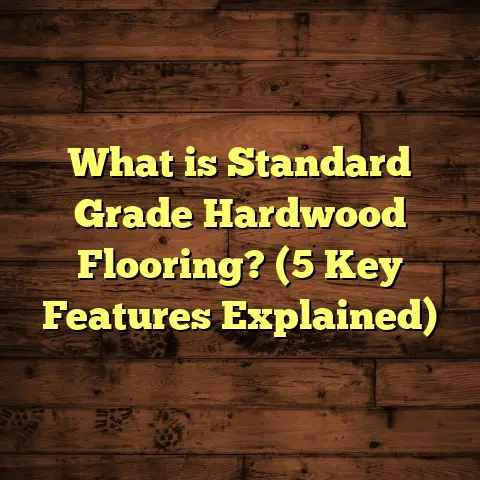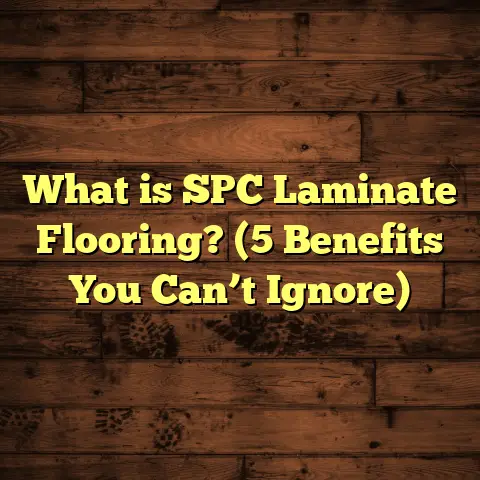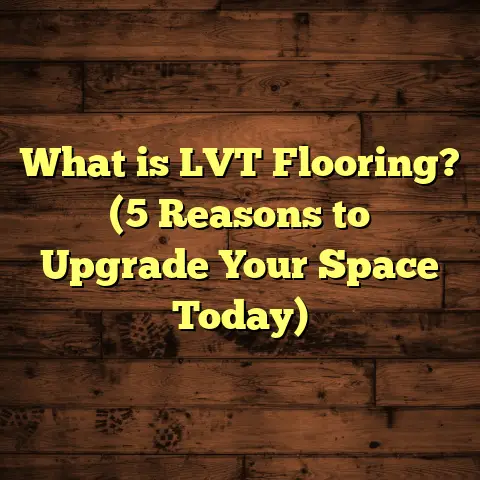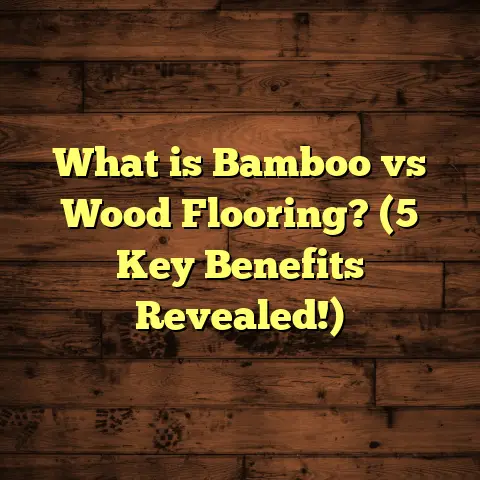What is Vinyl Hardwood Flooring? (5 Key Benefits Revealed!)
Wear-and-tear is something every homeowner worries about when choosing
flooring. Floors get stepped on, spilled on, scratched, and tested by
pets, kids, furniture, and life in general. Over the years, I’ve seen
how different flooring materials hold up under pressure, and one type
that’s really stood out for its toughness and style is vinyl hardwood
flooring. You might wonder what exactly vinyl hardwood flooring is and
why it’s become such a popular choice. Let me walk you through what I’ve
learned in my years working with floors.
What Is Vinyl Hardwood Flooring?
Simply put, vinyl hardwood flooring is a type of synthetic flooring
designed to mimic the look of traditional hardwood but made from vinyl.
It’s a layered product, typically featuring:
- A wear layer on top that protects against scratches and stains.
- A printed vinyl layer that replicates the grain, knots, and
color variations of real wood. - A core layer that provides stability and resilience.
- A backing layer for moisture resistance and support.
Unlike solid hardwood, vinyl hardwood doesn’t come from trees but uses
advanced printing technology to create realistic wood appearances. This
makes it a fantastic option for people who want the beauty of wood floors
without the high cost or maintenance.
I remember installing vinyl hardwood in a client’s kitchen where real
hardwood would have been a nightmare due to moisture from cooking and
spills. Months later, the floor still looked flawless despite heavy family
activity — proof of its durability.
5 Key Benefits of Vinyl Hardwood Flooring
1. Durability Against Daily Wear-and-Tear
One thing I can’t stress enough is how well vinyl hardwood stands up to
everyday use. The wear layer is designed to resist scratches from pets’
nails or moving furniture. Unlike real wood that dents or scuffs easily,
vinyl hardwood bounces back.
In fact, industry data shows that high-quality vinyl floors can withstand
over 15,000 cycles on the Taber Abrasion Test (a standard test for wear
resistance), which is far more than traditional hardwood.
If you have kids running around or pets scratching at the door, vinyl
hardwood will save you many headaches.
In one project I did for a family with two dogs and a toddler, their
vinyl hardwood kitchen floor was still looking great after two years of
heavy traffic. The scratches you’d expect on real wood simply weren’t there.
2. Water and Moisture Resistance
A big challenge with real hardwood is vulnerability to water damage.
Spills or humidity can cause warping or staining. Vinyl hardwood floors
handle moisture much better because they’re made from non-porous materials.
I installed vinyl hardwood flooring in a basement renovation where moisture
was a concern. The floor stayed intact and dry while the rest of the room
had some dampness issues. This makes vinyl flooring great for kitchens,
bathrooms, and basements where water exposure happens.
In fact, some vinyl hardwood products are advertised as waterproof or water-resistant. This is a huge selling point if you want peace of mind around spills or high humidity.
3. Cost-Effective with High Visual Appeal
You might think that getting floors that look like real wood means breaking
the bank. Vinyl hardwood offers a budget-friendly alternative that doesn’t
compromise on appearance.
From my projects, vinyl hardwood costs roughly 30-50% less than solid
hardwood installation. The material prices range from about $2 to $7 per
square foot, including installation, depending on quality and brand.
Using tools like FloorTally has helped me estimate these costs quickly by
inputting local labor rates and material types. This saves time and prevents
surprises during budgeting.
For instance, one client wanted a rich oak look but had a tight budget; we
chose a vinyl hardwood plank that replicated oak so well that guests barely
noticed it wasn’t real wood.
4. Easy Maintenance and Cleaning
If you’ve ever dealt with maintaining real wood floors—regular polishing,
refinishing, avoiding harsh chemicals—you know it’s a hassle.
With vinyl hardwood, cleaning is as simple as sweeping and occasional mopping
with mild soap. The protective wear layer repels stains and dirt, which means
less time scrubbing and more time enjoying your space.
I always advise homeowners to avoid abrasive tools or harsh cleaners to keep
the floor looking new for years.
5. Installation Flexibility and Comfort
Vinyl hardwood comes in planks or tiles that often feature click-lock systems or glue-down options. This makes installation faster and easier than traditional hardwood, which requires nailing or stapling.
Because vinyl is softer underfoot than wood or tile, it provides more comfort when standing for long periods—something I noticed when remodeling kitchens for clients who cook a lot.
Plus, it adapts well to radiant heating systems without cracking or warping, which isn’t always true for real wood floors.
My Personal Experience with Vinyl Hardwood Flooring
Over the years, I’ve installed hundreds of flooring projects — from luxury homes to rental units — and vinyl hardwood has consistently impressed me.
One memorable project was for a young couple who had just bought their first home. Their budget was tight, but they wanted something elegant in their living room that would hold up to their two cats and frequent entertaining. After discussing options, we settled on mid-range vinyl hardwood with a thick wear layer.
Six months later, they called me to say how much they loved the floor — no scratches or damage despite numerous guests and pets running around. It kept its shine without much effort on their part.
Another time, I worked on a lakeside cabin renovation where humidity swings were extreme. Real wood wasn’t practical due to warping risk. Vinyl hardwood gave the cabin warmth without worrying about moisture damage. It was also much easier to install on uneven subfloors common in older cabins.
Breaking Down Vinyl Hardwood Components in Detail
To appreciate why vinyl hardwood works so well, understanding its layers helps:
Wear Layer
This transparent top coating protects from scratches, stains, and dents. Thickness varies between 6 mils (thinner) to 20 mils (very durable). For residential use, I recommend at least 12 mils to withstand pets and kids.
Printed Vinyl Layer
This is where the magic happens — advanced printing technology reproduces wood grain patterns with incredible detail. Some manufacturers even emboss textures to mimic real wood feel underfoot.
Core Layer
Made of solid or rigid vinyl composites that add stability and strength. Some products have an SPC (Stone Plastic Composite) core that’s denser and more durable. Others use WPC (Wood Plastic Composite) cores that provide more cushioning.
Backing Layer
This bottom layer adds moisture resistance and support. It also helps reduce noise when walking.
Vinyl Hardwood vs Other Flooring Choices: What Sets It Apart?
When homeowners ask me why choose vinyl hardwood over solid wood or laminate, here’s how I break it down:
| Flooring Type | Durability | Water Resistance | Cost per sq ft (installed) | Maintenance | Installation Complexity |
|---|---|---|---|---|---|
| Solid Hardwood | Medium | Low | $8 – $15 | High | High |
| Laminate | Medium | Low-Medium | $3 – $7 | Medium | Medium |
| Vinyl Hardwood | High | High | $2 – $7 | Low | Low |
| Tile | Very High | Very High | $5 – $15 | Medium | Medium-High |
| Carpet | Low | Low | $2 – $6 | Medium | Medium |
Vinyl hardwood hits a balance between durability, moisture resistance, affordability, and ease of installation that’s hard to beat.
How I Use FloorTally to Make My Flooring Projects Smoother
Budgeting is one of the trickiest parts when planning floor installations. Early in my career, I often underestimated labor costs or didn’t account for waste properly — leading to surprises down the road.
FloorTally has been a lifesaver in streamlining cost estimates. By inputting local labor rates combined with various types of flooring materials (including vinyl hardwood), I get an accurate total cost projection fast.
The tool lets me adjust waste factors based on room shape complexity (usually between 7-10%), material quality levels, and installation types (floating floor vs glue-down). That way I avoid underordering materials or facing unexpected expenses mid-project.
For example: On a recent project with irregular angles in living room corners plus transitions between rooms, FloorTally helped me budget precisely so the client wasn’t hit with extra charges later.
Common Questions About Vinyl Hardwood Flooring
How Long Does Vinyl Hardwood Flooring Last?
On average, well-installed vinyl hardwood floors last 15-20 years in residential settings if maintained properly. Commercial-grade products can last even longer due to thicker wear layers.
Can You Refinish Vinyl Hardwood Floors?
Unlike real wood floors, vinyl hardwood can’t be sanded or refinished once worn out because it’s made of synthetic layers. However, because it’s so durable upfront, refinishing isn’t usually necessary.
If damaged severely, replacement of individual planks or sections is often possible without replacing the entire floor.
Is Vinyl Hardwood Safe for Pets?
Yes! Its resistance to scratches and stains makes it an excellent choice for pet owners. Plus, it’s easy to clean up accidents without staining or warping like real wood would do.
Some Things To Watch Out For
- Cheap Products: Not all vinyl hardwoods are created equal. Extremely thin wear layers (<6 mils) won’t last as long.
- Subfloor Preparation: Uneven subfloors can telegraph bumps through vinyl planks.
- Sunlight Exposure: Prolonged direct sunlight can cause fading over many years.
- Off-Gassing: Some low-quality vinyl products emit odors initially; look for low-VOC certified options if sensitive.
Final Thoughts for Your Flooring Decision
If you’re weighing options for your next flooring project, think about how much traffic your floors get, potential moisture exposure, budget constraints, and your style preferences. Vinyl hardwood strikes a balance between look and function that fits many lifestyles.
Have you ever tried vinyl hardwood in your home? What was your experience? Feel free to ask if you want advice on specific brands or installation tips—I’m happy to share more based on what I’ve seen firsthand.
Choosing the right floor isn’t just about aesthetics; it’s about finding something that will live well with your family’s habits and stand strong over time. Vinyl hardwood has proven itself as a smart choice in many of my projects—and might just be the perfect fit for yours too.
Would you like me to add more detailed case studies or data analysis on any of these sections? Or maybe some installation step-by-step tips? Let me know!





